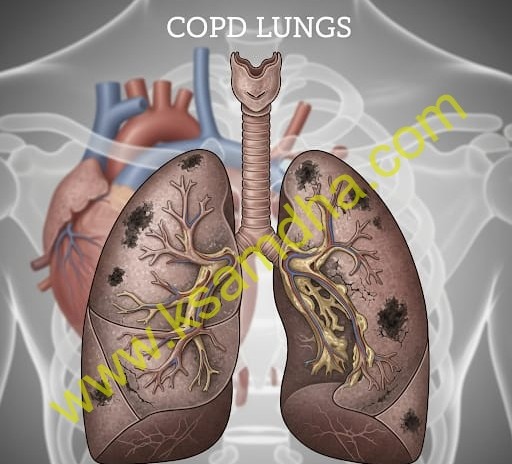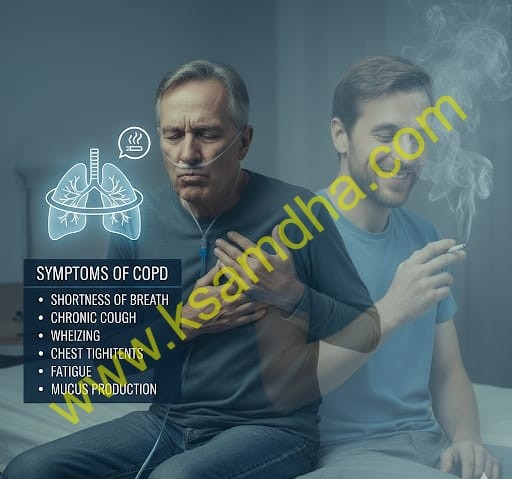COPD stands for Chronic Obstructive Pulmonary Disease. It refers to a group of progressive lung diseases that block airflow and make it hard to breathe. The damage caused to the lungs in COPD is usually irreversible but can be slowed with proper treatment and lifestyle changes.

Chronic Obstructive Pulmonary Disease (COPD): Causes, Symptoms, Diagnosis, Treatment, and Prevention
Chronic Obstructive Pulmonary Disease (COPD) is one of the most common chronic respiratory diseases worldwide. It is a progressive lung condition that makes it difficult for people to breathe due to obstruction of airflow. COPD is not a single disease but a combination of two main conditions: chronic bronchitis and emphysema.
According to the World Health Organization (WHO), COPD is currently one of the leading causes of illness and death, especially in developing countries where smoking, air pollution, and occupational exposure are high. Because COPD is a long-term and preventable disease, early awareness, timely diagnosis, and effective management are essential.
https://ksamdha.com/what-is-tuberculosis-tb/
The two main components of COPD are:
- Chronic Bronchitis – Long-term inflammation of the airways (bronchi), which causes mucus production, coughing, and obstruction of airflow.
- Emphysema – A condition in which the tiny air sacs (alveoli) in the lungs are damaged, reducing the surface area for gas exchange and leading to breathlessness.
Causes of COPD
COPD develops due to long-term exposure to irritants that damage the lungs and airways. The most common causes include:
- Smoking
- The leading cause of COPD globally.
- Cigarette smoke damages lung tissue, irritates the airways, and increases mucus production.
- Even passive smoking (secondhand smoke) increases COPD risk.
- Air Pollution
- Household air pollution from burning wood, coal, or biomass fuels for cooking and heating is a significant cause in rural areas.
- Outdoor pollution from vehicles, industries, and construction dust also worsens COPD.
- Occupational Hazards
- Long-term exposure to dust, chemicals, fumes, and vapors in industries like mining, construction, and manufacturing increases COPD risk.
- Genetics
- A rare inherited condition called Alpha-1 Antitrypsin Deficiency can lead to early COPD, even in non-smokers.
- Respiratory Infections
- Repeated childhood lung infections weaken the lungs and increase susceptibility to COPD later in life.
Risk Factors of COPD
- Not everyone exposed to irritants develops COPD. Risk factors include:
- Smoking history (duration and quantity).
- Age above 40 years.
- Family history of lung diseases.
- Poor nutrition and low body immunity.
- Gender – COPD is becoming more common among women due to increasing smoking rates.
Symptoms of COPD
COPD symptoms often appear gradually and worsen over time. Many patients mistake early symptoms for normal aging or smoking effects. Common symptoms include:

- Chronic Cough – Often called “smoker’s cough,” persistent and usually with mucus.
- Excess Mucus (Phlegm) Production – Especially in the morning.
- Shortness of Breath (Dyspnea) – Initially during exertion, later even at rest.
- Wheezing – Whistling sound when breathing.
- Chest Tightness – Discomfort or heaviness in the chest.
- Frequent Respiratory Infections – Such as cold, flu, or pneumonia.
- Fatigue and Weakness – Due to poor oxygen supply.
- Weight Loss – In severe stages, due to energy used in breathing.
Stages of COPD
The GOLD (Global Initiative for Chronic Obstructive Lung Disease) classification divides COPD into stages based on severity:
- Mild (Stage I): Chronic cough and mucus, slight breathing problems.
- Moderate (Stage II): Worsening shortness of breath, frequent flare-ups.
- Severe (Stage III): Increased airflow limitation, reduced quality of life.
- Very Severe (Stage IV): Life-threatening, with frequent hospitalizations.
Diagnosis of COPD
Early diagnosis is crucial for better management. Doctors use the following tests:
- Medical History and Physical Exam
- Detailed smoking history, occupational exposure, and family history.
- Physical examination with stethoscope to check for wheezing and crackling sounds.
- Spirometry (Pulmonary Function Test)
- The most reliable test for COPD.
- Measures how much air you can exhale and how quickly.
- Chest X-Ray or CT Scan
- Shows lung damage, emphysema, or other related conditions.
- Arterial Blood Gas Test
- Measures oxygen and carbon dioxide levels in the blood.
- Laboratory Tests
- For suspected Alpha-1 Antitrypsin Deficiency.
Complications of COPD
- If untreated, COPD can lead to:
- Respiratory failure.
- Heart problems (cor pulmonale).
- Pulmonary hypertension.
- Recurrent lung infections.
- Osteoporosis and muscle weakness due to reduced activity.
- Depression and anxiety due to poor quality of life.
Treatment of COPD
Although COPD cannot be completely cured, treatments aim to relieve symptoms, prevent complications, and slow disease progression.
- Lifestyle Changes
- Quit Smoking: The most effective step in preventing further lung damage.
- Avoid Air Pollution: Use masks, avoid dusty environments, and improve indoor ventilation.
- Healthy Diet: Balanced nutrition to maintain body weight and immunity.
- Regular Exercise: Pulmonary rehabilitation exercises to strengthen breathing muscles.
- Medications
- Bronchodilators: Inhalers (short-acting and long-acting) that relax airway muscles.
- Corticosteroids: Reduce airway inflammation.
- Antibiotics: For bacterial lung infections.
- Phosphodiesterase-4 Inhibitors: Reduce inflammation in severe COPD.
- Oxygen Therapy
- For patients with low oxygen levels, long-term oxygen therapy improves survival.
- Pulmonary Rehabilitation
- Supervised exercise, breathing techniques, and education programs to improve lung capacity.
- Surgical Options (for severe cases)
- Lung Volume Reduction Surgery: Removing damaged lung tissue.
- Bullectomy: Removal of large air pockets (bullae).
- Lung Transplant: For end-stage COPD.
Prevention of COPD
- Since COPD is preventable, adopting protective measures is essential:
- Quit smoking and avoid secondhand smoke.
- Use protective gear in workplaces with dust or fumes.
- Reduce indoor air pollution by using clean cooking fuels.
- Get vaccinated against flu and pneumonia.
- Regular health checkups for early detection.
Living with COPD
- COPD is a lifelong condition, but self-care and proper management can improve quality of life. Patients should:
- Follow medication schedules strictly.
- Use breathing techniques like pursed-lip breathing and diaphragmatic breathing.
- Stay active with mild exercises like walking, yoga, and stretching.
- Join COPD support groups for mental health support.
ksamdha
